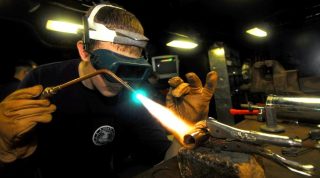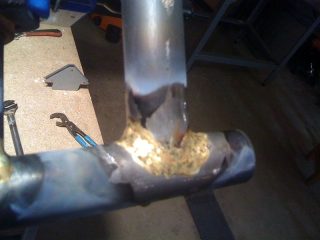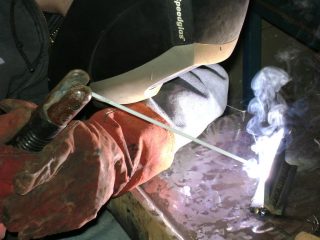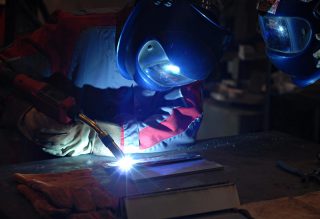If you want to learn how to weld then you’re in the right spot! I’m going to show you everything you need to know to get started welding with very little upfront costs, even if you’re a complete beginner!
Welding is the process of joining 2 metals together by heating them up to molten hot temperatures and then manipulating the molten weld puddle to create a weld bead.
That’s just the beginning of learning how to weld though.
A lot is involved with welding like metal cleaning, fit up, cutting, making measurements, making sure you’re using the correct welding processes, and much more.
Controlling the liquid weld puddle is where lots of practice comes into play.
The heat required to get mild steel to its melting point is around 2700 °F. Each welding process heats the metal to a different temperature.
For example, the heat created from an oxy-acetylene torch tip is around 6300 °F, which is plenty of heat to melt the steel.
Arc welding produces a heat at the electrode tip of around 6,000 to 10,000 °F.
I’m going to cover the different welding processes here and tell you what the uses and benefits of each process are, which one is the best for beginners who want to learn how to weld
[elementor-template id=”13402″]
How To Weld In The Early Days: Blacksmithing

Blacksmiths had to heat up the metal using a heating forge, and rather than bring the metal to a liquid temperature and weld it, they had to hammer the steel together.
This process fused the metal together, and it’s called forge welding. Up until the mid-1800’s most welding was done this way.
Even though this welding process is long and arduous, it’s still the same exact concept as gas welding or arc welding.
Essentially you’re joining 2 metals together.
Oxy Acetylene Welding

Oxy acetylene welding uses high pressure gas cylinders that contain the two gases oxygen and acetylene. The gases are able to be mixed and used for welding through the use of regulators, hoses, the torch mixer, and welding tips.
After turning on the gases and lighting them, they must be adjusted for the correct flame to weld properly. You must direct the flame at the weld joint and use a filler rod to help make the weld bead.
Now, I may have simplified that a bit because there are a few more steps on how to weld using oxy acetylene. For one you have to choose the proper welding tip for the metal thickness you’re working with.
You have to use a bigger tip for thicker metal, and a smaller tip for thinner metal. You also have to adjust the regulator pressures to deliver the right amount of gases at the welding tips.
If you have the pressures set wrong you may over heat the metal, or not heat it up enough to start the weld. Oxy acetylene is a slow welding process since it takes time for the flame to heat the metal to molten temperature.
When working with mild steel over ¼” inch thick, it’s best to just avoid using the oxy acetylene process altogether since it just takes too long, and the heat affected area is too large.
Arc welding has essentially taken the place of oxy acetylene welding since it’s come into use. Arc welding is much faster, much more efficient, and produces better welds. You can also weld thicker metals with the arc welding process.
Oxy Acetylene Brazing: Joining Dissimilar Metals

Most metal types can be brazed. For instance, you can braze copper, stainless steel, brass, mild steel, cast iron, bronze, galvanized steel, and more.
And with brazing you can join different metals with each other. You could join brass and copper together, steel to copper, etc.
Brazing is a good process because it requires much less heat to perform than does welding, which results in less metal warpage. This is why brazing is popular to use in automotive sheet metal.
It takes about 2,700°F to melt steel, but when you’re brazing you are only heating the metal to around 1,000°F.
Brazing typically involves using a brass filler rod with a flux to remove surface impurities and provide a good adhesion of the two metals.
Many people think that since you’re not actually melting the two metals together, but rather joining the two pieces of metal with a brass filler rod that adheres to the metals, that the brazed joint isn’t as strong.
However, in many cases during pull tests the steel will break before the actual brazed joint breaks.
Arc Welding (a.k.a. stick)

Arc welding or “stick welding” as it’s referred, uses a flux covered rod to weld with. Flux is a chemical coating that’s used when welding to protect the liquid weld puddle from atmospheric gases like nitrogen and oxygen.
If you attempt to arc weld without a flux covered welding rod your welds will come out weak and full of porosity.
“Porosity” is when you get lots of holes in your weld from not having an atmospheric shielding agent like flux when welding.

You can weld many different metals with an arc welder. For instance, you can weld stainless steel, bronze, aluminum, mild steel, and cast iron.
You just have to make sure you’re using the correct stick electrode for whichever metal you’re welding. If you’re welding steel then you will use a steel electrode, and the same goes for every type of metal you’re welding.
The process of learning how to weld with an arc welder starts by choosing the correct electrode. Once the electrode has been chosen, the next step is to ground your workpiece.
The weld cannot begin until you’ve grounded the workpiece with your ground clamp. Now you can turn on the machine, set your machines output level, and strike the arc.
Once the arc is started you will see a molten puddle form. Your job is to control this puddle and make it go where you want it to.
Since you’ll just be learning, it’s important when learning how to weld that you practice running many weld beads in the flat position before you attempt to make any weld joints.
MIG Welding (a.k.a. wire feed welding)

It’s called Metal Inert Gas because it uses an inert gas like co2 and argon to shield the weld puddle from atmospheric gases like nitrogen and oxygen that can weaken the weld.
The wire electrode comes on a spool and is placed inside the MIG welding machine. It’s fed through a gun that feeds the wire when the trigger is pulled.
MIG welding is similar to stick welding in that you must ground the workpiece with the ground clamp before you start the weld.
The process of learning how to mig weld is much faster than stick welding because you have a continuous wire being fed, and you don’t have to change out spent electrodes.
The MIG welding method was popularized in industry when manufacturers needed a fast method of welding.
MIG welding is by far the easiest way to learn how to weld due to its simplicity. Besides some metal fit up and preparation, you are really ready to weld with a MIG welder right out of the box.
TIG Welding (The Cadillac Process)
TIG welding (tungsten inert gas) is the Cadillac of the welding processes. You can produce the most beautiful welds by using a TIG welder.
TIG is an extremely accurate welding process. You can weld extremely thin metals together like 2 coke cans or 2 razor blades using TIG. You can successfully weld very thin metals to very thick metals because TIG welding doesn’t heat up a large area of the work piece.
TIG welding uses a torch with a solid tungsten electrode, an argon shielding gas, and a filler rod that gets dipped into the weld puddle.
TIG is very similar to oxy acetylene welding since both use a filler rod to dip into the weld puddle. However, with TIG you can weld steel, stainless steel, aluminum, titanium, magnesium, and more.
TIG uses a foot pedal to control the heat of the torch. You push forward for more heat and push back to reduce heat. The TIG process creates a lot of heat at the torch and can become uncomfortable to hold, so manufacturers make TIG welders with water cooling systems built in.
TIG is an advanced welding process to learn how to weld with that you probably want stay away from until you’ve mastered the MIG and arc welding processes.


